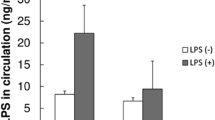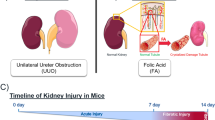Abstract
Renal scarring is a serious complication of chronic pyelonephritis that occurs due to vesicoureteral reflux. In our study, we performed global expression profiling of the kidney during renal scarring formation in a rat pyelonephritis model. An inoculum of Escherichia coli was injected directly into the renal cortex. Histologically, renal scarring developed during the 3-to-4 week period after injection. The time-course expression profile of 18,442 genes was then analyzed using microarrays, followed by validation with real-time reverse transcriptase-polymerase chain reaction (RT-PCR). Most of the genes found to be up-regulated during renal scarring are associated with immune and defense responses, including cytokines, chemokines and their receptors, complement factors, adhesion molecules and extracellular matrix proteins. These genes were up-regulated as early as 1 week after injection, when no fibrotic changes were yet evident, peaked at 2 weeks, and gradually decreased thereafter. However, a subset of cytokine genes was found to be persistently activated even at 6 weeks after injection, including interleukin (IL)-1β, transforming growth factor (TGF)-β, and IL-3. Further statistical analysis indicated that the pathways mediated by these cytokines are activated concomitantly with renal scarring formation. The products of these genes may thus potentially be novel non-invasive diagnostic or prognostic biomarkers of renal scarring.





Similar content being viewed by others
References
International Reflux Study Committee (IRSC) (1981) Medical versus surgical treatment of primary vesicoureteral reflux: a prospective international reflux study in children. J Urol 125:277–283
Meguid El Nahas A, Bello AK (2005) Chronic kidney disease: the global challenge. Lancet 365:331–340
Liu Y (2006) Renal fibrosis: new insights into the pathogenesis and therapeutics. Kidney Int 69:213–217
Eikmans M, Baelde HJ, de Heer E, Bruijn JA (2002) RNA expression profiling as prognostic tool in renal patients: toward nephrogenomics. Kidney Int 62:1125–1135
Choi H, Oh SJ, So Y, Lee DS, Lee A, Kim KM (1999) No further development of renal scarring after antireflux surgery in children with primary vesicoureteral reflux: review of the results of 99mtechnetium dimercapto-succinic acid renal scan. J Urol 162:1189–1192
Svanborg Edén C, Kulhavy R, Mårild S, Prince SJ, Mestecky J (1985) Urinary immunoglobulins in healthy individuals and children with acute pyelonephritis. Scand J Immunol 21:305–313
Hedges S, Stenqvist K, Lidin-Janson G, Martinell J, Sandberg T, Svanborg C (1992) Comparison of urine and serum concentrations of interleukin-6 in women with acute pyelonephritis or asymptomatic bacteriuria. J Infect Dis 166:653–656
Agace WW, Hedges SR, Ceska M, Svanborg C (1993) Interleukin-8 and the neutrophil response to mucosal gram-negative infection. J Clin Invest 92:780–785
Martins SM, Darlin DJ, Lad PM, Zimmern PE (1994) Interleukin-1B: a clinically relevant urinary marker. J Urol 151:1198–1201
Grandaliano G, Gesualdo L, Bartoli F, Ranieri E, Monno R, Leggio A, Paradies G, Caldarulo E, Infante B, Schena FP (2000) MCP-1 and EGF renal expression and urine excretion in human congenital obstructive nephropathy. Kidney Int 58:182–192
Gbadegesin RA, Cotton SA, Coupes BM, Awan A, Brenchley PE, Webb NJ (2002) Plasma and urinary soluble adhesion molecule expression is increased during first documented acute pyelonephritis. Arch Dis Child 86:218–221
Prat C, Domínguez J, Rodrigo C, Giménez M, Azuara M, Jiménez O, Galí N, Ausina V (2003) Elevated serum procalcitonin values correlate with renal scarring in children with urinary tract infection. Pediatr Infect Dis J 22:438–442
Hewitson TD, Wu HL, Becker GJ (1995) Interstitial myofibroblasts in experimental renal infection and scarring. Am J Nephrol 15:411–417
Matsumoto T, Haraoka M, Mizunoe Y, Takahashi K, Kubo S, Sakumoto M, Tanaka M, Kumazawa J (1995) Preventive effect of ulinastatin on renal scarring in rat model of pyelonephritis induced by direct or ascending infection with Serratia marcescens or Escherichia coli. Nephron 69:65–70
Tullus K, Hörlin K, Svenson SB, Källenius G (1984) Epidemic outbreaks of acute pyelonephritis caused by nosocomial spread of P fimbriated Escherichia coli in children. J Infect Dis 150:728–736
Söderhäll M, Normark S, Ishikawa K, Karlsson K, Teneberg S, Winberg J, Möllby R (1997) Induction of protective immunity after Escherichia coli bladder infection. J Clin Invest 100:364–372
Hultgren SJ, Schwan WR, Schaeffer AJ, Duncan JL (1986) Regulation of production of type 1 pili among urinary tract isolates of Escherichia coli. Infect Immun 54:613–620
Langermann S, Möllby R, Burlein JE, Palaszynski SR, Auguste CG, DeFusco A, Strouse R, Schenerman MA, Hultgren SJ, Pinkner JS, Winberg J, Guldevall L, Söderhäll M, Ishikawa K, Normark S, Koenig S (2000) Vaccination with fimH adhesion protect cynomolgus monkeys from colonization and infection by uropathogenic Escherichia coli. J Infect Dis 181:774–778
Takahashi K, Muratani T, Saito M, Matsumoto T (2001) Inflammatory mediators in urosepsis using rat urinary tract infection models. Hinyokigeka 14:643–646
Kusaka M, Kuroyanagi Y, Kowa H, Nagaoka K, Mori T, Yamada K, Shiroki R, Kurahashi H, Hoshinaga K (2007) Genomewide expression profiles of rat model renal isografts from brain dead donors. Transplantation 83:62–70
Hewitson TD, Darby IA, Bisucci T, Jones CL, Becker GJ (1998) Evolution of tubulointerstitial fibrosis in experimental renal infection and scarring. J Am Soc Nephrol 9:632–642
Jahnukainen T, Chen M, Celsi G (2005) Mechanisms of renal damage owing to infection. Pediatr Nephrol 20:1043–1053
Mezzano SA, Droguett MA, Burgos ME, Ardiles LG, Aros CA, Caorsi I, Egido J (2000) Overexpression of chemokines, fibrogenic cytokines, and myofibroblasts in human membranous nephropathy. Kidney Int 57:147–158
Mishra J, Dent C, Tarabishi R, Mitsnefes MM, Ma Q, Kelly C, Ruff SM, Zahedi K, Shao M, Bean J, Mori K, Barasch J, Devarajan P (2005) Neutrophil gelatinase-associated lipocalin (NGAL) as a biomarker for acute renal injury after cardiac surgery. Lancet 365:1231–1238
Blobe GC, Schiemann WP, Lodish HF (2000) Role of transforming growth factor beta in human disease. N Engl J Med 342:1350–1358
Border WA, Noble NA (1994) Transforming growth factor beta in tissue fibrosis. N Engl J Med 331:1286–1292
Eikmans M, Baelde HJ, Hagen EC, Paul LC, Eilers PH, De Heer E, Bruijn JA (2003) Renal mRNA levels as prognostic tools in kidney diseases. J Am Soc Nephrol 14:899–907
Tullus K, Wang JA, Lu Y, Burman LG, Brauner A (1996) Interleukin-1 alpha and interleukin-6 in the urine, kidney, and bladder of mice inoculated with Escherichia coli. Pediatr Nephrol 10:453–457
Haraoka M, Senoh K, Ogata N, Furukawa M, Matsumoto T, Kumazawa J (1996) Elevated interleukin-8 levels in the urine of children with renal scarring and/or vesicoureteral reflux. J Urol 155:678–680
Haraoka M, Matsumoto T, Takahashi K, Kubo S, Tanaka M, Kumazawa J (1994) Suppression of renal scarring by prednisolone combined with ciprofloxacin in ascending pyelonephritis in rats. J Urol 151:1078–1080
Acknowledgments
We thank T. Muratani for providing the SEC strain, and S. Nagao for technical assistance. We are also very grateful to H. Kogo, M. Taniguchi, T. Ohye, and H. Inagaki for their helpful discussions. This study was supported by a grant-in-aid for 21st Century COE program from the Ministry of Education, Science, Sports and Culture of Japan.
Author information
Authors and Affiliations
Corresponding author
Rights and permissions
About this article
Cite this article
Ichino, M., Mori, T., Kusaka, M. et al. Global gene expression profiling of renal scarring in a rat model of pyelonephritis. Pediatr Nephrol 23, 1059–1071 (2008). https://doi.org/10.1007/s00467-007-0717-6
Received:
Revised:
Accepted:
Published:
Issue Date:
DOI: https://doi.org/10.1007/s00467-007-0717-6




